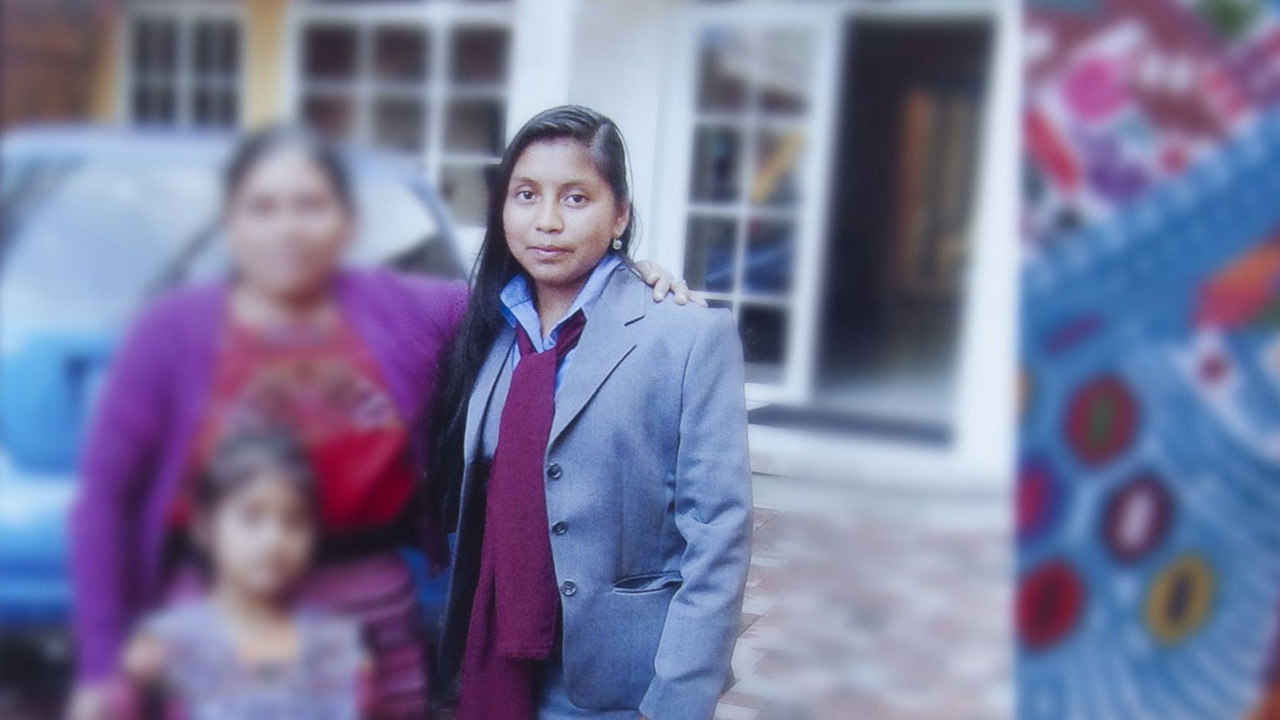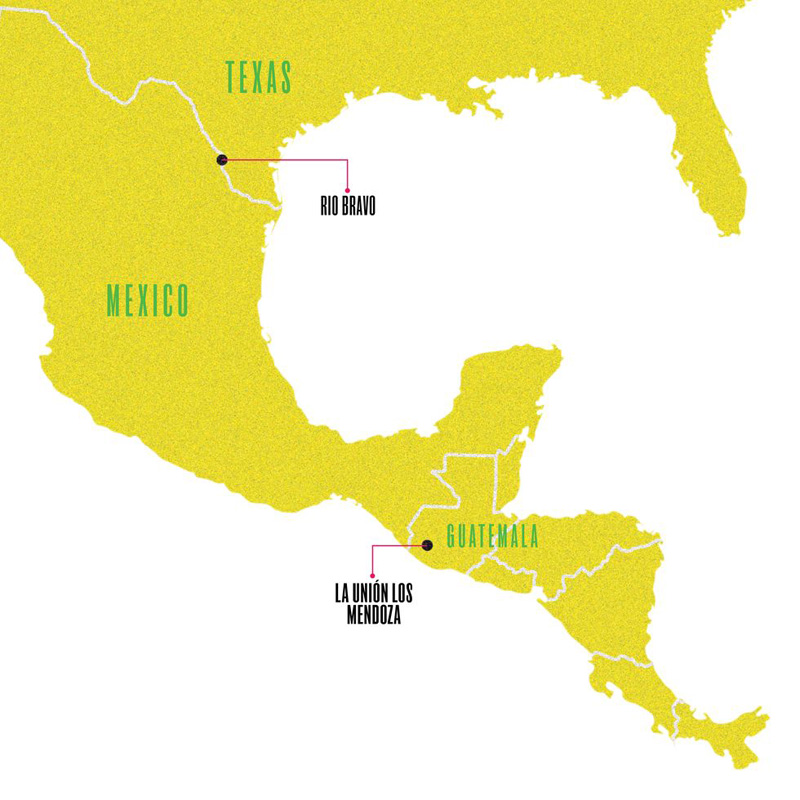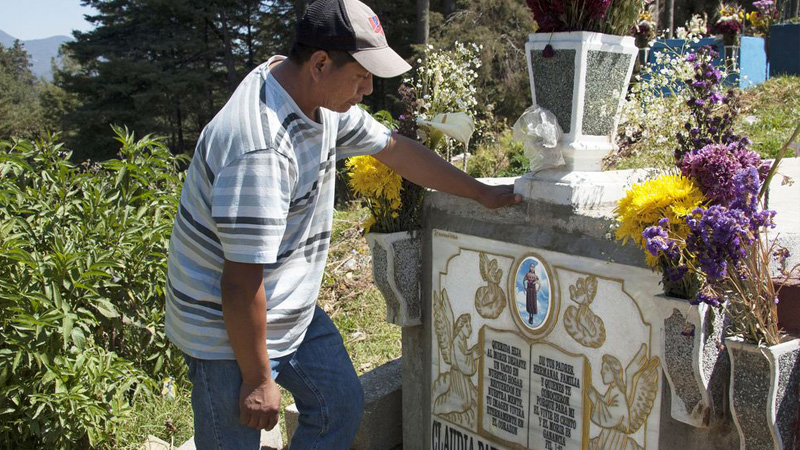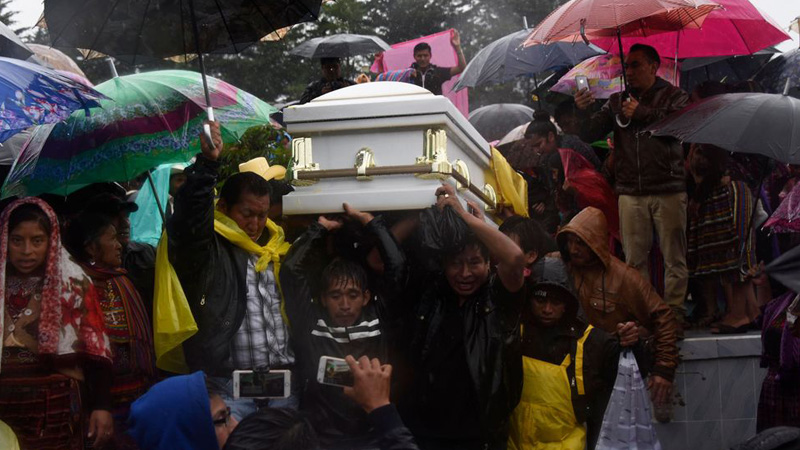Who Killed Claudia Gomez?
A year ago this month, a 20-year-old Guatemalan woman seeking opportunity in the U.S. was shot dead by a Border Patrol agent in Texas. A video of the killing went viral on Facebook and spurred a media outcry, yet neither the agent’s name nor why he opened fire has ever been made public. In the first of our series on women and migration, we ask, will her family ever get justice?

When Claudia Patricia Gómez González graduated high school two years ago—the first in her family to do so—she had tears in her eyes. One of the brightest students in her class, she had always been told that she was special, that she would go on to do great things and make her small village, La Unión Los Mendoza in the impoverished Guatemalan highlands, proud. “She was always so kind, so humble,” says Andres Vicente, a primary-school teacher in Claudia’s village. “It’s not easy for indigenous Mayans in this country, especially women, but we always knew Claudia was unique. Everyone thought she’d find a way to get out of here.”

But a year after graduating in 2017, Claudia started losing hope. Her family couldn’t afford college, and she wasn’t able to find a job—she wanted to be an accountant—without a degree. Instead, she spent most of her time listening to gospel music and weaving indigenous clothes to sell at markets in Quetzaltenango, the nearest city, about an hour away.
“Papa, what if I leave for America like you did?” she began asking her father, Gilberto Gómez. Gilberto had spent four years in Atlanta before he was deported in August 2017. His work as an electrician there afforded his family back home a decent three-room house, a luxury for many in the community. Since returning to his village, he hasn’t been able to find steady work—the reason he left Guatemala in the first place. More than half of Guatemalans live in poverty, and in the western highlands, where the majority of the population is indigenous, 76 percent live below the poverty line. “Claudia, you’re an adult. I can’t stop you from leaving,” Gilberto told his daughter. “But the journey won’t be easy.”
On May 7, 2018, Claudia packed some extra clothes and corn she had helped her mom grow in their small backyard and kissed her two little sisters, Edith, 12, and Emelin, 7, goodbye.
Claudia, whose parents nicknamed her La Princesita, or “little princess,” continued to apply for entry-level accounting and administrative jobs, but as the rejections piled up, she saw migrating to the United States as her only hope. Even as President Donald Trump ramped up his hard-line rhetoric against illegal immigration—warning of “an invasion” of migrants surging toward the border—Claudia kept showing her parents photos on Facebook of Mayan women from nearby villages who had arrived safely in the U.S. “If they can do it, so can I,” she told her mother, Lidia González. She knew of a few coyotes, or smugglers, who could guide her travel. Her aunt, who lives in Atlanta, offered to loan her the $11,000 she needed for the journey. Claudia had a plan: She’d live with her aunt, clean homes, and eventually move to Virginia to meet her boyfriend from a nearby village who had been living there for a year. “It’s a risk, but I’m wasting away here,” she cried to her parents. “I want to be somebody.”
So on May 7, 2018, Claudia packed some extra clothes and corn she had helped her mom grow in their small backyard and kissed her two little sisters, Edith, 12, and Emelin, 7, goodbye. “I was sad,” Lidia recalls, sorting through the traditional square-cut blouses that Claudia had embroidered. “But I was also happy. She wants to follow her dreams, and she’s so smart. There’s nothing here. How can you blame her?” Claudia walked by her favorite lemon tree in the small courtyard of their home and touched the leaves one last time. The 20-year-old had a bus to catch to Quetzaltenango and a new life to build. “Don’t worry—I will make you very proud of me,” she told her parents before the gate closed behind her.
It was the last time they’d ever see their daughter.
Almost two weeks later, on May 23, 2018, about 1,500 miles north of Guatemala, in Rio Bravo, Texas, a town roughly a mile north of the U.S.–Mexico border, Marta Martinez was getting ready for her son’s end-of-year school ceremony when she heard a gunshot only feet from her home and ran outside. Over the chain-link fence separating her property from an adjacent lot, she told the Los Angeles Times, she saw a U.S. Border Patrol agent with a gun in his hand. When she looked down, she saw a young woman lying facedown and bleeding.
Get exclusive access to fashion and beauty trends, hot-off-the-press celebrity news, and more.

Lidia holding a photo of her daughter, Claudia.
It was Claudia. She had been shot in the head. “Why did you shoot the girl? You killed her!” Martinez is heard saying to Border Patrol agents in one of several videos she uploaded on Facebook Live. (One of the videos garnered 5.2 million views before Martinez took them down.) “I saw you with the gun.” Martinez kept filming as agents arrested two migrants who had been traveling with Claudia. “This is what happens. You see?” Martinez says she heard an agent tell the men. Once news of the killing reached Claudia’s family, images of her, wearing brightly colored hand-sewn indigenous dresses, spread across social media with the hashtag #SayHerName. Reporters from all over the country descended upon the tiny hamlet of Rio Bravo, and local advocacy groups held vigils with signs reading “We Are All Claudia.”
It has now been a year since a Border Patrol agent shot Claudia, and silence still shrouds the case. If Martinez hadn’t run outside that afternoon with her phone, Claudia’s parents say, they doubt they’d even know that their daughter had made it across the border. “We got a call later that day from a relative in Atlanta,” Gilberto says. “She was crying, saying she read on the Internet that Claudia was murdered. We couldn’t breathe.” Even worse, he says, was breaking the news to their younger daughters, who saw Claudia as a second mother. “They haven’t been the same since we told them,” says Gilberto. “We try not to say her name in front of them or they’ll get too upset, asking what happened.” Gilberto isn’t hopeful they’ll ever find out. “So much time has passed, and yet we still have no answers. Who is the agent that shot her? Why did he shoot her?” says Juanita Cabrera Lopez, the executive director of the D.C.-based International Mayan League. “The media storm is over, but we refuse to ignore this murder. The U.S. Border Patrol took an innocent life, and justice must be served.”
Within three days of Claudia’s death, U.S. Customs and Border Protection (CBP), the Border Patrol’s parent agency, released two contradictory statements about what happened near Martinez’s home. In its first statement, on the day of the killing, CBP said the officer was searching for “illegal activity” in the border town when a group of “illegal aliens” attacked him with “blunt objects.” Two days later, the agency updated its statement, claiming that the agent told the immigrants “to get on the ground” but “the group ignored his verbal commands and instead rushed him.” The earlier statement said that the officer, whose name has still not been released, fired at least one shot from his handgun, “fatally wounding one of the assailants.” The updated statement did not refer to Claudia as an “assailant,” saying instead that the officer fired one round that struck “one member of the group.” The Border Patrol agent has been put on administrative leave, and the FBI and Texas Rangers are investigating the shooting. Neither agency has released any information about the case, and the CBP, the FBI, Texas Rangers, and a lawyer representing the Border Patrol agent did not respond to requests for comment. The ACLU in Texas says it is proceeding with a lawsuit against the U.S. on behalf of Claudia’s parents; the lawsuit is in its early stages, and the ACLU says it cannot yet release information, but as the organization pursues civil, not criminal, cases, presumably it is seeking compensation for Claudia’s family.

The patch of grass in Rio Bravo where Claudia was shot.
A lawyer familiar with the case says it’s unlikely justice will be served any time soon. For six years, the family of 16-year-old Jose Antonio Elena Rodriguez sought to have the U.S. Border Patrol agent Lonnie Swartz punished after he fired 16 times from Arizona across the border fence into Mexico, killing their son in October 2012. In April 2018, a jury cleared Swartz, who said he fired in self-defense against rock-throwing smugglers, of second-degree murder but could not agree on a lesser charge of manslaughter. In November, another jury acquitted him of involuntary manslaughter. “We’re talking about a militarized law-enforcement agency—the largest in the U.S.—that acts with impunity under an administration that has called immigrants animals. There usually isn’t accountability with these cases,” the lawyer says. An investigation by The Guardian in 2018 found that since 2003, CBP agents have killed 97 people—citizens and noncitizens alike, with most deaths occurring in states near the Mexican border. The investigation also revealed that the U.S. government has paid over $60 million in legal settlements to cover claims against the agency in which border agents were involved in deaths, driving injuries, alleged assaults, and wrongful detention.
Martinez, the neighbor who recorded the immediate aftermath of the killing, has declined to talk to the press as she’s now considered an official witness in the investigation. “It’s hard to get anyone in this town to talk. There’s a culture of silence here, and we’re all still demanding answers,” says Ilse Mendez, a spokesperson for the Laredo Immigrant Alliance, an advocacy group in the area. “Claudia could have been any of us. The Border Patrol has been acting with brutal force for years. The only difference is that this time they were filmed.”
Batches of yellow flowers line the dirt road to Claudia’s village. The municipality is known for high rates of outward migration, driven by years of poverty, droughts, and the brutal legacy of a 36-year civil war that has kept the indigenous population—almost half of the country—an underclass with little access to adequate social services. During the war, more than 200,000 people—mostly indigenous—were killed. After it formally ended in 1996, a report by a U.N.-backed truth commission found security forces had inflicted “multiple acts of savagery” and genocide against Mayan communities, which they saw as allies of the leftist guerrillas fighting to overthrow the government. The commission also found that U.S. military and intelligence assistance in Guatemala had a “significant bearing on human rights violations during the armed confrontation.” (In 1999, President Bill Clinton apologized for the U.S.’s support of right-wing governments in Guatemala.)
The conflict has had a lasting impact on the Mayan communities. Well-known indigenous anthropologist Irma Alicia Velásquez wrote last year that Guatemalans “leave because they want to break the curse that steals their dreams from the moment they are born.” Nearly half of Guatemalan children under five are malnourished—the worst level of malnutrition in the Western hemisphere. Only one in four Guatemalan children attends middle school or beyond. “It’s no surprise that Claudia was an indigenous Mayan woman,” says Jordan Rodas, Guatemala’s human-rights ombudsman. His office in Guatemala City is lined with security detail as political tensions in the country have risen. Over the last year, more than 20 Guatemalan human-rights defenders, many indigenous, have been murdered, and in January Guatemalan president Jimmy Morales moved to expel a U.N.-backed commission investigating corruption in the country. “Claudia is a victim of two governments,” says Rodas. “Sadly, as we’ve seen, she won’t be the last.”
Claudia is a victim of two governments. Sadly, as we’ve seen, she won’t be the last.
On Christmas Eve 2018, Felipe Gomez Alonzo, an 8-year-old indigenous Guatemalan, suffered a fever and died in U.S. custody at a New Mexico hospital. Three weeks earlier, 7-year-old Jakelin Caal, also an indigenous Guatemalan, died of sepsis shock, fever, and dehydration at El Paso Children’s Hospital after being detained with her father. Despite the deaths and the Trump administration’s threats that anyone entering the U.S. without documentation will be charged with a crime—even those requesting asylum—as well as a policy to separate children from their parents at the border, Guatemalans are still making the trek north in search of a better life.
According to Customs and Border Protection data, between October 2017 and September 2018, 50,401 Guatemalans traveling as families were apprehended at the U.S.–Mexico border, nearly twice the amount as in the previous year. (It’s unclear whether those apprehended were sent back home or if they remain in detention centers.) In that same time frame, Guatemalans accounted for nearly half of all migrants who sought to enter the U.S. with their relatives—more than those from El Salvador, Honduras, and Mexico combined. “North seems like the only answer,” says Gilberto, Claudia’s father. An American flag still hangs over the window in a small room where Claudia used to sew clothes and where the family received visitors after Claudia’s body was sent back to Guatemala. (Gilberto and Lidia requested that the casket remain unsealed until they could dress Claudia in indigenous clothes for her burial in a nearby village.) “You can’t really be anything around here,” he says. “More and more people are leaving. Our country depends on it.”

Claudia journeyed from her hometown, La Unión Los Mendoza, in Guatemala, through Mexico to border town Rio Bravo, Texas, where she was killed.
Remittances, or money sent from abroad, make up a tenth of Guatemala’s gross domestic product. According to the Pew Research Center, Guatemalan immigrants—the majority living in the U.S.—sent home $7.5 billion in 2016. In 2010, a town not far from Claudia’s erected a 40-foot statue called Homage to the Migrants. It faces north to the United States. “There won’t be a solution to the migration issue in the United States until you fix the root of the problem in Guatemala,” says Ursula Roldán Andrade, the director of the Institute for Research and Social Projection on Global and Territorial Dynamics at Rafael Landívar University in Guatemala City, the country’s capital. “You have a corrupt government that fails to recognize an indigenous population and continues to ignore the plight of most of the country. Claudia’s death represents this disease. So do little Felipe’s and Jakelin’s.”
Interviews with dozens of Guatemalans revealed that few are hopeful the families of those who died will ever find justice. “The Guatemalan government simply doesn’t want to confront the Trump administration,” says Jean Paul Briere, a congressman in Guatemala. “Trump is supporting the corruption in Guatemala, so our government has no interest in going up against his racist policies, even if they kill our own people.” Since his election in 2015, Guatemalan president Morales, an evangelical Christian, has forged alliances with conservative politicians and organizations in the U.S. (For example, he was the first world leader to show support for the Trump administration’s controversial decision to move the U.S. embassy in Israel to Jerusalem.) Despite calls from members of the U.S. Congress urging Trump to impose sanctions on corrupt officials in the Guatemalan government, critics say the Trump administration has turned a blind eye. As Briere flips through his phone’s photo gallery, which is filled with pictures of his own children interspersed with those of Jakelin, Felipe, and Claudia, he adds, “That’s why there haven’t been any proper investigations, or even messages of condolences, about any of these deaths. Both the U.S. and Guatemalan governments have that in common: They just don’t care about these people. They’re seen as disposable. Their lives don’t matter.”
The first time Heder, 20, saw Claudia, he says he couldn’t believe someone so tiny had made the arduous journey up north by herself. After all, he was a self-described “brave man,” and at several points during the 1,500-mile trek, he didn’t think he’d make it. The two young Guatemalans met at a “waiting house” in Mexico on May 22, a day before Claudia was killed. They were among a group of approximately 15 migrants who had been staying there, waiting for a signal from their respective coyotes to cross the winding Rio Grande into the U.S. Millions of migrants have walked or paddled across the river in search of the American dream, which Heder now calls a “nightmare.”
Like Claudia, Heder, who asked that his last name be omitted for fear of retribution, grew up in the western highlands of Guatemala and couldn’t find a job. He lost relatives in the civil war and says he has never felt that he had a place in the country. His older brother migrated to the U.S. four years ago and has made a decent living working as a cook in Maryland, so Heder took out a string of loans and paid a smuggler $11,000 to guide him to the waiting house near the U.S. border.

Claudia’s father, Gilberto, at her grave.
On the morning of May 23, Heder and Claudia shared breakfast—a small piece of bread—and hopped into a car with four other migrants. Less than 10 minutes later, they arrived at a low point in the river bank. Their coyote said that after crossing the river in a raft, they should make their way to a designated house not far across the border and await further instructions. “We looked at each other, a little scared but mostly excited,” Heder recalls. “We thought that this would be the beginning of a new life.”
They crossed without incident, found the house, and huddled inside. But Heder says they were there for only 20 minutes before someone shouted a warning into the house: “Quick! A Border Patrol agent is coming! Run!” Heder says he, Claudia, and the four others ran from the house to a nearby bushy area. Two of the migrants continued to run, but four of them—including Claudia—hid behind some shrubs. As the Border Patrol officer approached, Heder says, he and two of the other migrants once again started running, but Claudia froze in fear. Heder was only a few yards away when he heard a gunshot and Claudia’s screams. “I didn’t know what was happening,” he recalls, denying that any of them charged the officer, despite the depictions in the two statements CBP released. “Everything was a blur and I was so scared, so I ran back to the house with one of the guys. I thought we were all going to die.”
It wasn’t long until a Border Patrol agent found him and the other migrant hiding back at the house. Heder says the officer handcuffed them and chained them together. They were thrown into a patrol car, and soon a sea of other Border Patrol officers arrived at the scene. “I didn’t actually think Claudia was dead until I heard neighbors screaming, ‘You killed a girl, you killed a girl,’ and out of the corner of my eye, I saw a dead body,” Heder recalls.
The next five months were torture, Heder says, as he was shuffled among a handful of detention centers and given little information. He says he was interviewed a few times by the FBI about Claudia’s murder and visited by officials from the Guatemalan consulate who assured him that he wasn’t in trouble. He filled his time singing songs in his head and tried to remember the contours of the village he was once so eager to leave but now deeply missed.
Last October, he was told he would be sent back to Guatemala. He shared a flight with dozens of other migrants who were also being deported. When they landed, he said they all looked at one another, unsure of what was next. He hopped on a bus to his village, filled with a mix of shame and relief. “When I left Guatemala, I knew it wouldn’t be easy, but I didn’t think it would be that hard,” he says from a small room he shares with five family members. He is still trying to figure out how he’ll pay back the smuggler and fears death if he can’t come up with the money. “We came close to freedom,” he says. “But in the end, it wasn’t enough, and an innocent girl died.” Naomi, his mother, says Heder is “practically dead.” He barely sleeps, and when he does he often wakes up screaming from nightmares.

Friends and family attend Claudia Gomez’s funeral.
Back in Claudia’s village, an hour’s drive from Heder’s home in the mountains, Claudia’s father, Gilberto, smiles into his phone, watching a video from a February rally in Washington, D.C. Dozens of protestors held up photos of Claudia, demanding justice. He then texted over WhatsApp with a group of artists in San Antonio who had constructed a memorial mural to Claudia. “People won’t forget her, right?” Gilberto asks no one in particular as he replays the video. Lidia looks down at the cold cement floor, not knowing how to answer her husband. “All she wanted was to dream,” she says as the sounds of their two daughters playing outside stream through the window. “When will we ever be able to dream?”
This article originally appeared in the May 2019 issue of Marie Claire.
RELATED STORY
